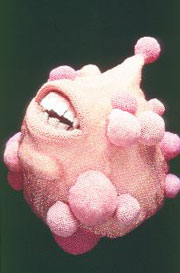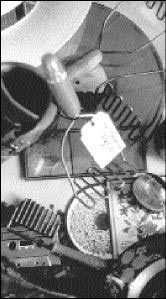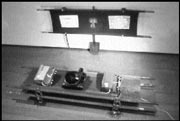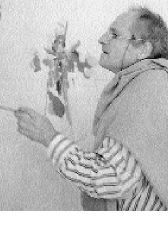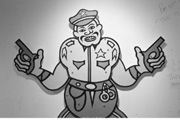AT THE INTERSECTION of craft, domestic chore, and contemporary sculpture, the fiber arts have steadily wound their way from the fringes of art production to the cutting edge. Running the gamut from feminist reappropriation of traditional women’s work to evocative abstractions of the body and nature, the work tends to possess intensely corporeal qualities that other media simply cannot.
Sewn
Seattle Art Museum ends July 22
Like skin and sinew, fibers are flexible and yielding. Fabric, string, yarn, and thread bow and bend to gravity’s pull; they hang and sag like our bodies. The physical immediacy of fiber art affects us on a visceral level. We can feel the tensions in a stitched object, the skinlike stretch of fabric, or the weight of a draped cloth. Further, as curator Rock Hushka puts it, fiber art reinforces the process, “the physical act of making as part of an object’s meaning.”
“Sewn,” a new show at Seattle Art Museum, reveals the mind-boggling diversity of approach in fiber art. Dolls, functional objects, anthropomorphic entities, or abstractions of the body, these works have a profound physical presence as well as a sense of play.
Where surrealism and beadwork intersect sits David Chatt. With thousands of tiny beads, Chatt creates high-art knickknacks, antidotes to an insistence on instant gratification. Chatt’s precious objects each take around 500 hours to make. His whimsical Flab Bag is a grotesque pink blob devoid of eyes but with a fully developed mouth and anus.
If FAO Schwartz was bought by Barnum & Bailey, you’d get Sara Lanzillotta. Her elaborately costumed dolls seem innocuous enough, bearing the soulless visages of generic toys: big empty eyes, Cheerio mouths, and button noses. But their thin disguises as lovable, cuddly toys are quickly detected as we see their multiple limbs, multiple heads, and other disfigurements. Felicia the Cat and Koo-Koo the Bird Girl is a vignette in a series of “circus sideshows.” Felicia—half-woman, half-cat—poses seductively on all fours, but all that remains of poor Koo-Koo is a flurry of feathers. It’s difficult to know when Lanzillotta is serious and when she’s toying with childish absurdities.
Where sweatshop worker and anthropologist cross paths is Wendy Hanson. Similarly playing with our notion of the plush toy and its cuteness, Wendy Hanson has made a collection of wingless red birds that lie toppled and inert. Far from adorable, the birds double as bloody human organs, representing corporeal vulnerability and hidden violence. Hanson’s black floral elements in Vanity, I’m Told, Is the Last Thing to Go are made with her own cast-off clothes. Like charred relics of a burned civilization, these drooping figures take on personalities as they fight gravity.
Alison Gates finds herself as a modern-day feminist confronting her turn-of- the-century sisters. Mocking traditional women’s work while drawing attention to expectations for ladylike behavior maintained decades after women put down their crochet needles, Gates’ handkerchiefs are embroidered with images of Southern belles whose hiked-up skirts reveal stilettos or devil hooves. She pokes fun at the thin veneer of feigned innocence that masks sexual desire and moral impurity.
Find Rachel Brumer where historian, linguist, and seamstress meet. Quire: Book of Findings is a series of hinged books spanning up to the ceiling. Inspired by Hebrew manuscripts, Brumer developed her own “language” for this piece by collecting objects on a walk (ࠬa Richard Long). Making prints with these objects, she tells a beautifully abstract story exploring our relationship with words and the significance of language in collective and personal histories.
Where taxidermy and haberdasher collide is Keith Yuranda. His ghastly yet exquisite inventions, Flora-grafts, look like hanging carcasses. By sewing hide over tree branch armatures, Yuranda makes intricate hybrids of plant and animal. Stretching the definition of fiber art to its outer limits, Yuranda explores the human propensity to tinker with the natural world. His hideous anthropomorphic sculptures are intriguing, beautiful, and disgusting all at once.
“Sewn,” like its predecessors in the PONCHO series, brings compelling works by emerging local artists to SAM’s hallowed halls. The show is small but well worth a visit. Let’s cross our fingers in hopes that we can look forward to equally quirky and adventurous exhibitions of grander scope when newly appointed Deputy Director and Curator of Modern and Contemporary Art Lisa Graziose Corrin joins the SAM staff in mid-September. Corrin has said that she intends to deepen the museum’s dialogue with local artists and collectors. With exciting curatorial feats under her belt from her stints in London at the Serpentine Gallery and at the Contemporary Museum in Baltimore, she promises a renewed focus on contemporary art.
